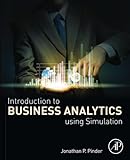Introduction to business analytics using simulation
By: Pinder, Jonathan P
Material type: BookPublisher: Amsterdam : Academic Press, Elsevier Science & Technology Books, c2017.Description: xiii, 434 p. : ill. ; 24 cm.ISBN: 9780128104842Subject(s): Business intelligence | Business -- Computer simulation | Industrial management -- Statistical methods | BUSINESS & ECONOMICS / Industrial Management | BUSINESS & ECONOMICS / Management Science
BookPublisher: Amsterdam : Academic Press, Elsevier Science & Technology Books, c2017.Description: xiii, 434 p. : ill. ; 24 cm.ISBN: 9780128104842Subject(s): Business intelligence | Business -- Computer simulation | Industrial management -- Statistical methods | BUSINESS & ECONOMICS / Industrial Management | BUSINESS & ECONOMICS / Management Science| Item type | Home library | Call number | Status | Date due | Barcode | Item holds |
|---|---|---|---|---|---|---|
| REGULAR | University of Wollongong in Dubai Main Collection | 658.40352 PI IN (Browse shelf) | Available | T0054642 | ||
| REGULAR | University of Wollongong in Dubai Main Collection | 658.40352 PI IN (Browse shelf) | Available | T0037112 |
, Shelving location: Main Collection Close shelf browser

|

|

|

|

|

|

|
||
| 658.40352 LA BU Business process modeling, simulation, and design / | 658.40352 PI CO Computer simulation in management science / | 658.40352 PI CO Computer simulation in management science / | 658.40352 PI IN Introduction to business analytics using simulation | 658.40352 PI IN Introduction to business analytics using simulation | 658.40352 PI TO Tools for thinking : modelling in management science / | 658.40352 PI TO Tools for thinking : modelling in management science / |
Introduction to Business Analytics using Simulation employs an innovative strategy to teach business analytics. It uses simulation modeling and analysis as mechanisms to introduce and link predictive and prescriptive modeling. Because managers do not know what will happen in the future but must make decisions, it treats uncertainty as an essential element in decision-making. Its use of simulation gives readers a superior way of analyzing past data, understanding an uncertain future, and optimizing results to select the best decision. With its focus on the uncertainty and variability of business, Introduction to Business Analytics Using Simulation provides a better foundation for business analytics than standard introductory business analytics books. Students gain a better understanding of fundamental statistical concepts that are essential to marketing research, Six-Sigma, financial analysis, and business analytics. Teaches how managers use business analytics to formulate and solve business problems and to support managerial decision making Explains the processes needed to develop, report, and analyze business data Describes how to use and apply business analytics software Includes 50 caselettes, quizzes for each exercise set, a quiz generator spreadsheet, and a sample syllabus.
Cover ; Title Page; Copyright Page; Contents; Preface; Acknowledgments; Chapter 1 -- Business analytics is making decisions; Introduction; 1.1 -- Business Analytics is making decisions subject to uncertainty; 1.2 -- Components of Business Analytics; 1.3 -- Uncertainty = probability = stochastic; 1.4 -- What is simulation?; 1.4.1 -- Why Use Simulation?; 1.4.2 -- Simulation Applications; 1.5 -- Monte Carlo simulation and random variables; 1.6 -- Simulation terminology; 1.7 -- Probability as relative frequency; 1.8 -- Overview of simulation process; 1.9 -- Random number generation in Excel 1.10 -- Extra practiceChapter 2 -- Decision-making and simulation; Introduction; 2.1 -- Introduction to decision-making; 2.1.1 -- Define the Problem; 2.1.2 -- Identify and Weight the Criteria; 2.1.3 -- Generate Alternatives; 2.1.4 -- Evaluate Each Alternative; 2.1.5 -- Compute the Optimal Decision; 2.2 -- Probability: the measure of uncertainty; 2.3 -- Where do the probabilities come from?; 2.4 -- Elements of probability; 2.5 -- Probability notation; 2.6 -- Examples of simulation and decision-making; Chapter 3 -- Decision Trees; Introduction; 3.1 -- Decision trees and expected value 3.2 -- Properties of decision trees3.2.1 -- Linear Transforms; 3.3 -- Overview of the decision making process; 3.4 -- Sensitivity analysis; 3.5 -- Expected value of perfect information; 3.6 -- Summary of the decision analysis process; Chapter 4 -- Probability: measuring uncertainty; Introduction; 4.1 -- Probability: measuring likelihood; 4.2 -- Probability distributions; 4.3 -- General probability rules; 4.4 -- Conditional probability and Bayes' theorem; Further exercises: common interview questions regarding probability; Chapter 5 -- Subjective Probability Distributions; Introduction 5.1 -- Subjective probability distributions-probability from experience5.2 -- Two-point estimation: uniform distribution; 5.2.1 -- Discrete Uniform Distribution; 5.3 -- Three-point estimation: triangular distribution; 5.3.1 -- Simulating a Symmetric Triangular Distribution; 5.3.2 -- Simulating an Asymmetric Triangular Distribution; 5.4 -- Five-point estimates for subjective probability distributions; 5.4.1 -- Simulating a Five-Point Distribution; 5.4.2 -- Other Estimates for Subjective Probability Distributions; Chapter 6 -- Empirical probability distributions; Introduction 6.1 -- Empirical probability distributions-probability from data6.2 -- Discrete empirical probability distributions; 6.3 -- Continuous empirical probability distributions; Chapter 7 -- Theoretical probability distributions; Introduction; 7.1 -- Theoretical/classical probability; 7.2 -- Review of notation for probability distributions; 7.3 -- Discrete theoretical distributions; 7.3.1 -- Uniform Distribution; 7.3.2 -- Discrete Uniform Distribution; 7.3.3 -- Continuous Uniform Distribution; 7.3.4 -- Bernoulli Distribution; 7.3.5 -- Binomial Distribution; 7.3.6 -- Poisson distribution 7.4 -- Continuous probability distributions
